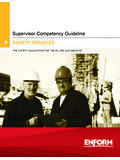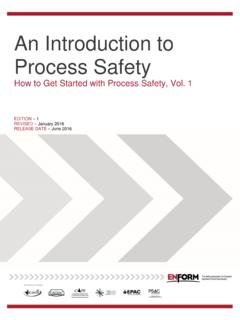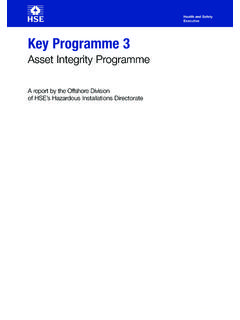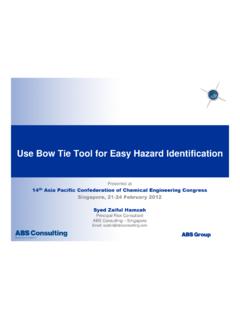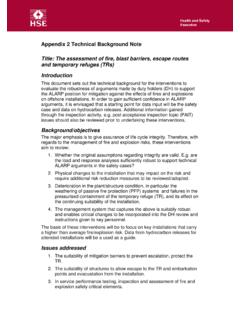Transcription of Process Safety Leading key performance indicators
1 Process Safety Leading key performance indicatorsSupplement to Report 456implementguideJULY2016 REPORT556 AcknowledgementsThis report was developed by the IOGP Process Safety used with permission courtesy of Olivier Lantzendorffer/iStockphoto and Georgijevic/iStockphoto (Front cover) FabioFilzi/iStockphoto (Back cover)DisclaimerWhilst every effort has been made to ensure the accuracy of the information contained in this publication, neither IOGP nor any of its Members past present or future warrants its accuracy or will, regardless of its or their negligence, assume liability for any foreseeable or unforeseeable use made thereof, which liability is hereby excluded.
2 Consequently, such use is at the recipient s own risk on the basis that any use by the recipient constitutes agreement to the terms of this disclaimer. The recipient is obliged to inform any subsequent recipient of such publication is made available for information purposes and solely for the private use of the user. IOGP will not directly or indirectly endorse, approve or accredit the content of any course, event or otherwise where this publication will be noticeThe contents of these pages are International Association of Oil & Gas Producers. Permission is given to reproduce this report in whole or in part provided (i) that the copyright of IOGP and (ii) the sources are acknowledged.
3 All other rights are reserved. Any other use requires the prior written permission of Terms and Conditions shall be governed by and construed in accordance with the laws of England and Wales. Disputes arising here from shall be exclusively subject to the jurisdiction of the courts of England and Safety Leading key performance indicatorsSupplement to Report 456 Revision 2016 First releaseJULY2016 REPORT5561. Introduction 52. Background 73. Concepts Incorporating barrier thinking Dual assurance Quantify locally and learn widely 174. Selection and review Selection of key barriers for KPIs Selection of indicators Review of KPIs Learning from Tier 1 and 2 events 245.
4 Example Leading indicators 25 Appendix A: Survey of industry practice of KPI implementation 35 References 41 Contents4 Process Safety Leading key performance indicators1. IntroductionThis is a supplement to the 2011 publication of Report 456, Process Safety Recommended Practice on key performance indicators [1]. It builds on the experience of IOGP member companies, and others, to provide further guidance for companies on how to establish Process Safety key performance indicators (KPIs) that are Leading . The overall aim is to enable companies to establish effective Leading indicators that proactively assess the health of barriers that manage the risk of Process Safety events (PSEs), particularly those that could result in a major PSEs are generally defined in terms of loss of primary containment (LOPC) of hydrocarbons, this guidance is equally applicable to other hazards that could be unintentionally released, such as electrical energy or kinetic/potential energy ( dropped objects and marine collisions).
5 The guidance focuses on the effectiveness of both hardware and human barriers, and supporting management system processes that are designed for either prevention of PSEs, or mitigation to avoid or reduce the potential consequences of report is presented in five sections, including three concepts that underpin this guidance:1) Introduction2) Background a brief summary of the past work by IOGP and others on the four tier model for Process Safety KPIs, including the more Leading indicators at the Tier 3 and Tier 4 (T3 and T4) levels3) Concepts three concepts underpin the guidance in this Barrier thinking establishing a standard set of Process Safety barriers that are regularly reviewed to identify those key barriers that need ongoing monitoring or require Dual assurance each key barrier is monitored using a combination of a) Tier 3 KPIs that track barrier weakness or impairment.
6 And b) Tier 4 KPIs that measure inputs that maintain barrier effectiveness. Measure locally and learn widely to be relevant and informative, Leading KPIs generally need to be sufficiently specific for asset -level application. At company level, review of KPI data promotes shared learning and improvement of barrier and management system Safety Leading key performance indicators4) Selection and review applies barrier thinking and dual assurance concepts within a continuous improvement Process to identify appropriate T3 and T4 KPIs and to ensure the KPIs are regularly assessed and updated, as ) Example Leading indicators good practice guidance to illustrate how example Tier 3 and 4 KPIs can be combined to monitor barriers (or Management System Elements).
7 The results of a survey of IOGP member practice and experience undertaken during January to April 2014 is summarized in Appendix this report is generally aligned with Report 456, there may be some areas of divergence that reflect progress in understanding and good practice related to Process Safety KPIs since 2011, and provides alignment with subsequent publications by IOGP and Safety Leading key performance indicators2. BackgroundIn November 2011, IOGP published Report 456, Process Safety Recommended Practice on key performance indicators [1], which built on Report 415, asset integrity the Key to Managing major Incident Risks [1], on earlier work by CCPS [3] and API [4], Report 456 introduced a four tier model for implementation of Process Safety KPIs by oil and gas producing model is illustrated by the pyramid diagram in Figure 1 that also illustrates the need for higher numbers of KPIs at the more Leading levels.
8 Tier 1 LOPC events ofgreater consequenceLeading indicatorsLagging indicatorsLOPC events oflesser consequenceChallenges to Safety systemsOperating discipline & managementsystem performance indicatorsTier 2 Tier 3 Tier 4 From ANSI/API RP 754 [4]Figure 1: Process Safety indicator pyramid Tier 1 and Tier 2 (T1 and T2) are well defined KPIs based on recording of PSEs that involve LOPC that either exceed gas or liquid release thresholds or result in serious consequences such as injury or fire. T1 and T2 PSEs are intended to be lagging indicators that have consistent definitions for both downstream and upstream oil and gas operations and can be benchmarked across the industry.
9 IOGP have published summary T1 and T2 data (actual and normalized) from IOGP member companies based on voluntary submission of annual data since 2011 [5].7 Process Safety Leading key performance indicatorsIn contrast, Tiers 3 and 4 (T3 and T4) provide an intentionally broader concept, with the aim of encouraging companies to introduce a range of more Leading KPIs that are typically defined locally at the facility or asset level, or in some instances across a business or company, to monitor the effectiveness of barriers that are specifically designed as risk controls at the operating report provides further guidance at the T3 and T4 level based on good practice that has emerged in the industry.
10 It captures and shares company experience in implementing KPIs since the launch of Report or Lagging?There can be confusion about the terms Leading and lagging . T3 and T4 KPIs are often both considered Leading because they are implemented to be predictive measures compared to the lagging T1 and T2 KPIs which track specific levels of LOPC PSEs including those resulting in incidents with severe consequences. However, when compared to the more proactive Leading KPIs within T4, the T3 KPIs are arguably lagging as these KPIs monitor events or conditions that indicate failures or weaknesses, such as a minor LOPC below the T2 indicated by the arrows on Figure 1, it is the combination of T3 and T4, together with the learnings from T1 and T2 events, which collectively provide lagging and Leading information to inform a company s actions to improve its barriers and risk management.


